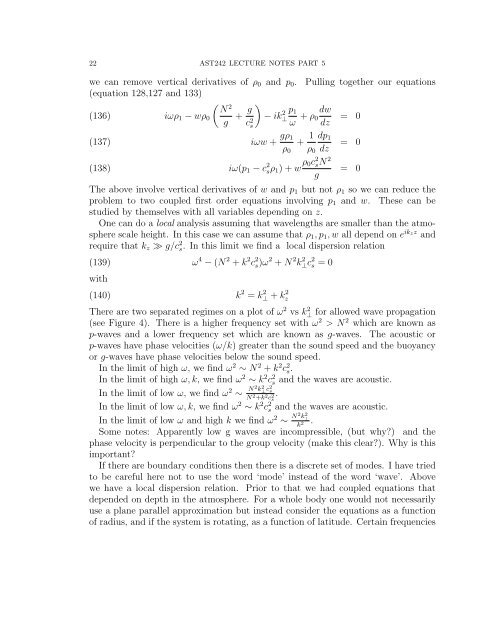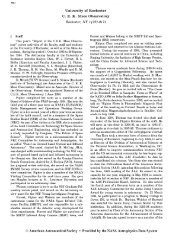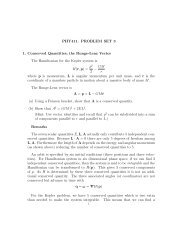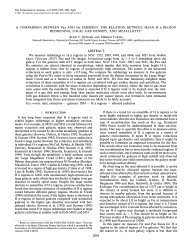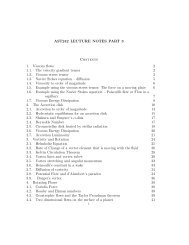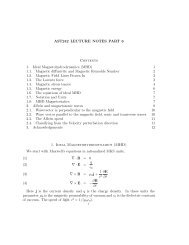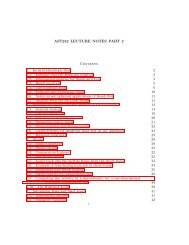AST242 LECTURE NOTES PART 5 Contents 1. Waves and ...
AST242 LECTURE NOTES PART 5 Contents 1. Waves and ...
AST242 LECTURE NOTES PART 5 Contents 1. Waves and ...
- No tags were found...
Create successful ePaper yourself
Turn your PDF publications into a flip-book with our unique Google optimized e-Paper software.
22 <strong>AST242</strong> <strong>LECTURE</strong> <strong>NOTES</strong> <strong>PART</strong> 5we can remove vertical derivatives of ρ 0 <strong>and</strong> p 0 . Pulling together our equations(equation 128,127 <strong>and</strong> 133)(136)( N2iωρ 1 − wρ 0g + g )− ik 2 p 1c 2 ⊥s ω + ρ dw0dz= 0(137)(138)iωw + gρ 1+ 1 dp 1ρ 0 ρ 0 dziω(p 1 − c 2 sρ 1 ) + w ρ 0c 2 sN 2g= 0= 0The above involve vertical derivatives of w <strong>and</strong> p 1 but not ρ 1 so we can reduce theproblem to two coupled first order equations involving p 1 <strong>and</strong> w. These can bestudied by themselves with all variables depending on z.One can do a local analysis assuming that wavelengths are smaller than the atmospherescale height. In this case we can assume that ρ 1 , p 1 , w all depend on e ikzz <strong>and</strong>require that k z ≫ g/c 2 s. In this limit we find a local dispersion relation(139) ω 4 − (N 2 + k 2 c 2 s)ω 2 + N 2 k 2 ⊥c 2 s = 0with(140) k 2 = k 2 ⊥ + k 2 zThere are two separated regimes on a plot of ω 2 vs k⊥ 2 for allowed wave propagation(see Figure 4). There is a higher frequency set with ω 2 > N 2 which are known asp-waves <strong>and</strong> a lower frequency set which are known as g-waves. The acoustic orp-waves have phase velocities (ω/k) greater than the sound speed <strong>and</strong> the buoyancyor g-waves have phase velocities below the sound speed.In the limit of high ω, we find ω 2 ∼ N 2 + k 2 c 2 s.In the limit of high ω, k, we find ω 2 ∼ k 2 c 2 s <strong>and</strong> the waves are acoustic.In the limit of low ω, we find ω 2 ∼ N 2 k⊥ 2 c2 s.N 2 +k 2 c 2 sIn the limit of low ω, k, we find ω 2 ∼ k 2 c 2 s <strong>and</strong> the waves are acoustic.In the limit of low ω <strong>and</strong> high k we find ω 2 ∼ N 2 k⊥2 .k 2Some notes: Apparently low g waves are incompressible, (but why?) <strong>and</strong> thephase velocity is perpendicular to the group velocity (make this clear?). Why is thisimportant?If there are boundary conditions then there is a discrete set of modes. I have triedto be careful here not to use the word ‘mode’ instead of the word ‘wave’. Abovewe have a local dispersion relation. Prior to that we had coupled equations thatdepended on depth in the atmosphere. For a whole body one would not necessarilyuse a plane parallel approximation but instead consider the equations as a functionof radius, <strong>and</strong> if the system is rotating, as a function of latitude. Certain frequencies


